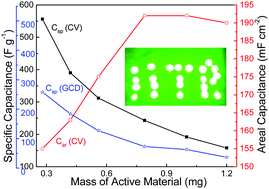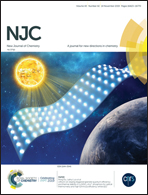A nitrogen and phosphorus enriched pyridine bridged inorganic–organic hybrid material for supercapacitor application†
Abstract
A new class of N- and P-enriched pyridine bridged inorganic–organic hybrid material is synthesized via the condensation of phosphonitrilic chloride trimer and 2,6-diaminopyridine at 140 °C for 18 h. It was used as the active electrode material for supercapacitor application. The role of mass loading on the overall performance of the HPHM supercapacitor electrode has been investigated. Specific capacitances of 243 and 107 F g−1 are estimated from cyclic voltammetry and galvanostatic charge–discharge measurements at a scan rate of 1 mV s−1 and current density of 0.5 A g−1, respectively. The high retention of 81% of the initial Csp value is observed after 2000 cycles at a current density of 5 A g−1. A fabricated solid-state symmetric supercapacitor device made with the optimal mass loading shows power and energy densities of 244 W kg−1 and 14.4 W h kg−1, respectively, and it could light up a green LED display (23 in total) for up to 50 s upon charging for 5 s at 3 V.



 Please wait while we load your content...
Please wait while we load your content...